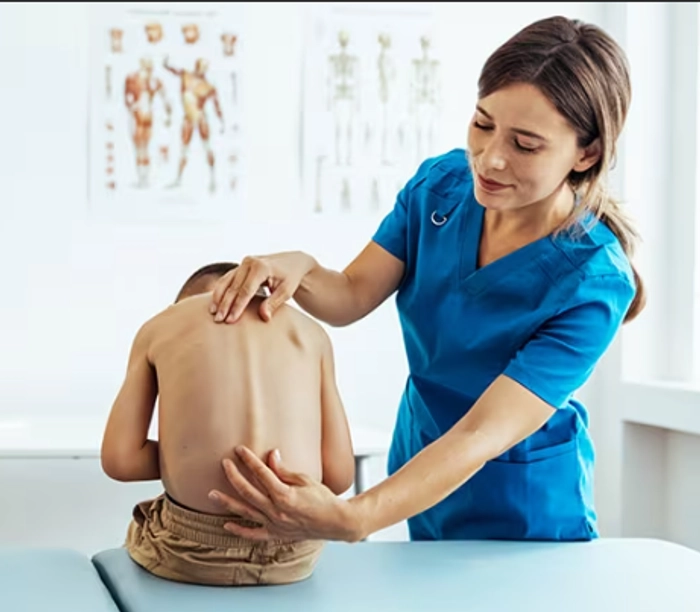Introduction
Adolescence is a critical period of growth and development, and it’s also when certain health issues, such as scoliosis, often become more apparent. Scoliosis, a condition characterized by an abnormal lateral curvature of the spine, affects approximately 2-3% of adolescents. Early detection and appropriate management are crucial for preventing the progression of scoliosis and ensuring a healthy spine. At Dhyan Healthcare, we are committed to helping parents and adolescents understand and manage scoliosis effectively. In this blog, we’ll explore what adolescent scoliosis is, its signs and symptoms, and the best approaches for management.
What is Adolescent Scoliosis?
Adolescent scoliosis is a condition where the spine curves sideways in a C- or S-shaped curve. It typically develops during the growth spurt just before puberty. While the exact cause of most scoliosis cases is unknown (idiopathic scoliosis), other types can result from neuromuscular conditions, congenital spine deformities, or injuries.
Signs and Symptoms
Early detection of scoliosis can significantly impact the effectiveness of treatment. Common signs and symptoms include:
- Uneven Shoulders: One shoulder may appear higher than the other.
- Prominent Shoulder Blade: One shoulder blade may stick out more than the other.
- Uneven Waist: The waist may appear uneven, with one hip higher than the other.
- Leaning to One Side: The entire body may lean to one side.
- Rib Hump: When bending forward, one side of the rib cage may appear higher than the other.
It’s important for parents to observe their child’s posture and look for these signs, especially during periods of rapid growth.
Diagnosis
If scoliosis is suspected, a healthcare provider will conduct a physical examination and may use the following methods to diagnose the condition:
- Adam’s Forward Bend Test: The child bends forward, and the examiner looks for asymmetries in the back.
- Scoliometer: A device used to measure the angle of trunk rotation.
- X-rays: X-rays of the spine are taken to determine the degree of the curve and monitor its progression.
Management and Treatment
The treatment approach for adolescent scoliosis depends on the severity of the curve and the risk of progression. Here are the main management strategies:
1. Observation
For mild scoliosis (curves less than 20 degrees) that is not progressing, regular monitoring is often recommended. This involves:
- Regular Check-ups: Scheduled visits to monitor the curve through physical exams and periodic X-rays.
- Activity Modification: Encouraging activities that promote good posture and spinal health.
2. Bracing
For moderate scoliosis (curves between 20 and 40 degrees) that is likely to progress, bracing may be recommended to prevent further curvature. Bracing does not correct scoliosis but can help stop its progression.
- Types of Braces: There are different types of braces, such as the Boston brace or the Milwaukee brace, which are chosen based on the curve’s location and severity.
- Wearing Schedule: Braces are typically worn for 16-23 hours a day, depending on the specific case.
- Compliance: Consistent use of the brace is crucial for its effectiveness.
3. Surgery
For severe scoliosis (curves greater than 40-50 degrees) or rapidly progressing curves, surgery may be necessary to correct the curve and stabilize the spine.
- Spinal Fusion: The most common surgical procedure, where the vertebrae are fused together to straighten the spine and prevent further curvature.
- Post-Surgery Care: Includes physical therapy and regular follow-up visits to ensure proper healing and spinal alignment.
4. Physical Therapy
Physical therapy can be beneficial for managing scoliosis, improving posture, and strengthening the muscles that support the spine.
- Schroth Method: A specialized exercise approach designed specifically for scoliosis patients.
- Core Strengthening: Exercises that strengthen the core muscles, improving overall spinal stability.
Living with Scoliosis
Living with scoliosis can be challenging for adolescents, both physically and emotionally. Here are some tips for managing daily life with scoliosis:
- Stay Active: Engage in regular physical activity, with a focus on low-impact exercises like swimming and cycling.
- Emotional Support: Encourage open communication about feelings and provide emotional support. Joining a support group can also be beneficial.
- Proper Posture: Practice good posture habits and use ergonomic furniture when studying or working.
Conclusion
Early detection and appropriate management of adolescent scoliosis are crucial for preventing progression and ensuring a healthy spine. At Dhyan Healthcare, we are dedicated to providing comprehensive care for adolescents with scoliosis. If you suspect your child may have scoliosis, schedule an appointment with our specialists for an evaluation and personalized treatment plan.


